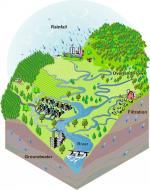|
This section contains 689 words (approx. 3 pages at 300 words per page) |

|
Systems are assemblages of interacting objects that are linked by transfers of energy and matter, behave in specific ways under certain conditions, and are often governed by cybernetic controls that involve the flow of information through positive and negative feedback. In 1935 British ecologist Arthur Tansley (1871-1955) described functioning organisms and their physical environment as the "basic units of nature on the face of the Earth" and referred to them by the term "ecosystem." The components are both living (within the biotic realm) and nonliving (abiotic). The biotic components comprise the communities of organisms formed by interacting populations. While ecosystems are real, functioning places, they are also the abstractions, or models, that are developed to characterize the function and potentially predict the behavior of these real places.
One important aspect of ecosystems is the definition of their boundaries. In some cases this is superficially obvious. A pond can be...
|
This section contains 689 words (approx. 3 pages at 300 words per page) |

|


